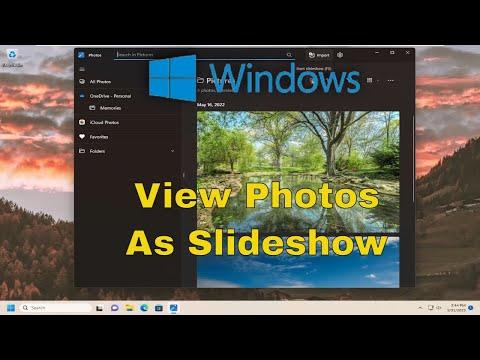I recently encountered an issue while trying to view a collection of photos as a slideshow on my Windows 11 laptop. The problem arose when I wanted to showcase some vacation photos to my friends and family, but I struggled to get the built-in tools to cooperate. My goal was to enjoy a seamless slideshow experience, similar to what I had done countless times on my previous Windows versions, but it seemed Windows 11 was throwing a wrench into my plans.
At first, I tried the standard method by selecting the photos in File Explorer and then using the “Slideshow” option from the right-click context menu. However, this approach was either not working or not providing the smooth, full-screen experience I was accustomed to. Instead, the slideshow would start in a windowed view, and the transition between photos was choppy. This was frustrating, especially when I had a large set of photos that needed to be displayed smoothly.
Determined to resolve this, I began searching for alternative solutions and stumbled upon several methods that could potentially solve my problem. After some experimentation and a bit of trial and error, I found a straightforward and effective solution that worked perfectly for me.
The first step I took was to use the Photos app, which is the default photo viewer on Windows 11. I opened the Photos app by either clicking on its icon from the Start Menu or by right-clicking on a photo and selecting “Open with” and then “Photos.” Once the Photos app was open, I navigated to the folder containing the photos I wanted to view.
In the Photos app, there is a convenient option for creating a slideshow. To access this, I clicked on the first photo in the folder to open it. Then, I clicked on the three dots (More options) in the top-right corner of the window and selected “Play slideshow” from the dropdown menu. The Photos app started the slideshow in full-screen mode, allowing me to view the photos one by one with smooth transitions. This method provided the seamless experience I was looking for, with minimal hassle.
In case you prefer more control over the slideshow settings or need additional features, another excellent option is to use the Windows Photo Viewer. Although Windows 11 does not include this application by default, I had it available from a previous installation of Windows 10. To use Windows Photo Viewer, I had to first enable it since it was hidden by default.
To re-enable Windows Photo Viewer, I followed these steps: I opened the Registry Editor by typing “regedit” into the Start Menu search bar and pressing Enter. I then navigated to the following path: HKEY_LOCAL_MACHINE\SOFTWARE\Microsoft\Windows Photo Viewer\Capabilities\FileAssociations. Here, I created a new string value for each file extension I wanted to associate with Windows Photo Viewer, such as “.jpg” and “.png”. After this, I made sure to set Windows Photo Viewer as the default program for these file types through the “Default Apps” settings in Windows 11.
With Windows Photo Viewer enabled, I could then right-click on a photo, choose “Open with,” and select Windows Photo Viewer. The viewer offered a simple and effective slideshow option, which I accessed by pressing the F11 key or clicking on the “Slideshow” button in the toolbar. The slideshow function was straightforward and allowed me to enjoy the photos without any of the issues I encountered with the Photos app.
For those who may want even more customization and features, there are third-party applications available that can enhance the slideshow experience. Programs like IrfanView or FastStone Image Viewer offer extensive options for customizing slide transitions, adding effects, and controlling the duration each photo is displayed. These tools can be particularly useful if you have specific preferences for your slideshow or if you need additional functionality that the built-in options do not provide.
In summary, my experience with viewing photos as a slideshow on Windows 11 involved a bit of troubleshooting and exploration. By using the built-in Photos app, I was able to achieve a smooth slideshow experience with minimal effort. For those who prefer the classic Windows Photo Viewer, re-enabling it and using it for slideshows is also a viable solution. Additionally, third-party applications offer enhanced features for those looking for more control over their slideshow presentations.
By following these steps and experimenting with different options, I was able to resolve my slideshow issue and enjoy sharing my photos effortlessly. Whether you choose the built-in tools or explore third-party options, the key is to find the solution that best fits your needs and preferences for an enjoyable photo viewing experience.
